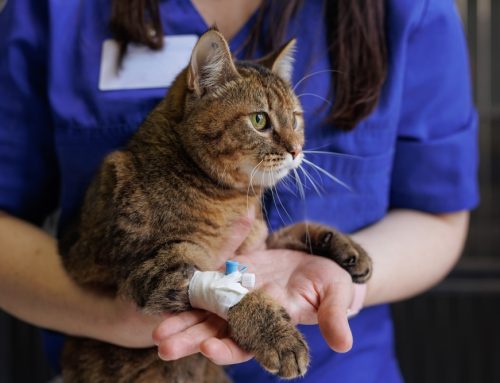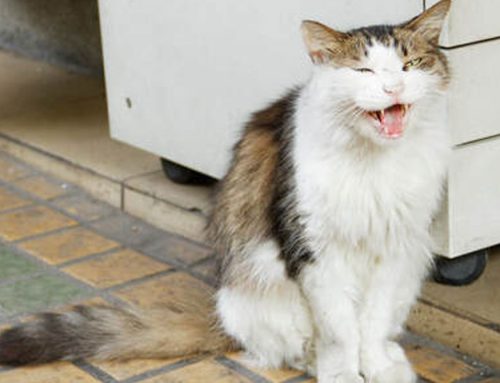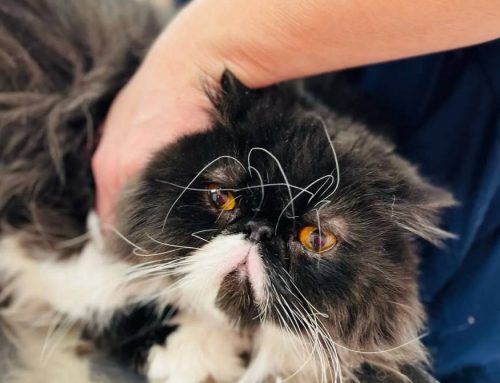
Ah-choo! Cats can sneeze for a variety of reasons ranging from no big deal to serious illness. Here’s how to tell whether to stay home and relax or call the vet.
Sneezing is a normal response to nasal irritation. Occasional sneezes are nothing to worry about, especially if your cat is immediately back to normal after the sneeze.
Sneezing can produce clear spray or thick snot. In general, clear spray sneezes are often viral or allergic in origin, while thicker green or yellow snot can mean bacterial or fungal infection. The nasal discharge can be present on both sides (bilateral), or just from one nostril (unilateral). Unilateral nasal discharge usually means something is structurally wrong, like an abscessed tooth or a foreign object stuck in the nasal passage. It always warrants a trip to the vet.
Causes of sneezing:
1. Viral upper respiratory infection – this is the most common cause of acute (rapid onset, short term signs), especially in shelters, boarding facilities, and outdoor cats. Herpes and calici viruses are the most common causes and are both highly contagious. Nasal discharge is bilateral, can be clear or white, there is often eye involvement, and it can be accompanied by fever. Signs will usually clear in 7-10 days, but cats can become chronic carriers and spread the virus to other cats.
2. Bacterial infection – bacterial infections are often secondary to another cause (like a foreign body or mass), but can also occur on their own. Chlamydophila, mycoplasma, and bordetella can all cause nasal infections. They usually show up with thick green/yellow discharge from both nostrils.
3. Allergies – environmental allergies can cause sneezing in cats just like in people. Molds, pollen, and dust mites are the common triggers. Nasal discharge is usually bilateral, clear, and watery. Anti-histamines like chlorpheniramine can help relieve symptoms.
4. Fungal infection – less common in Ohio than in the Southwest, cryptococcus infections can cause severe destruction and remodeling of the sinus, leading to facial asymmetry. Affected cats will have thick and sometimes bloody nasal discharge, and often only one nostril is affected.
5. Foreign object – cats can inhale grass awns, seeds, or bits of plant material. Acute onset severe sneezing, pawing at the face, and unilateral nasal discharge are signs that something could be stuck.
6. Dental disease – tooth root abscesses can breach the nasal cavity and lead to nasal discharge and sometimes bloody noses. This is usually unilateral, and the discharge is usually thick and green/yellow.
7. Polyps – polyps are benigns growths that can cause severe nasal discharge from secondary infections. Discharge is usually unilateral and thick green/yellow. Young cats are the most commonly affected. The polyps can grow toward the ear as well. They will often cause congested breathing sounds.
8. Cancer – older cats can develop cancer within the sinuses or nasal turbinates that leads to nasal discharge and facial asymmetry. Usually the discharge is unilateral, and it can sometimes be bloody.
9. Idiopathic – there are some cats with chronic (long-standing) disease for whom no cause can be found. It is possible that early episodes of viral or bacterial infection remodeled the nasal turbinates or sinuses and predispose these cats to inflammation throughout their lives. While they can rarely be cured, signs can usually be managed to the point that these cats are comfortable and living well.
When to see the vet:
- Any sneezing cat with a decreased appetite needs to see the veterinarian. Cats are very sensitive to smell, and many will not eat if they can’t smell their food. A thick snotty nose definitely impairs ability to smell, so these cats need help quick. Offering smelly canned foods and tuna can perk up an appetite, and hanging out in a steamy bathroom or near a humidifier can also help loosen nasal secretions.
- Fever is another reason to see the veterinarian. If your cat has decreased energy or is running a fever (most accurately measured rectally by your veterinarian), veterinary care is needed.

- Lethargy or trouble breathing – if the congestion impacts your cat’s ability to play and exercise or if your cat ever appears to be in distress, seek veterinary care immedicately.
- Unilateral (one-sided) nasal discharge or bloody nose – since this often means there’s a foreign object or structural reason behind the sneezing, seek veterinary care quickly.
- Thick green/yellow snot, or any sneezing that lasts more than a couple weeks
When you can wait:
- Acute sneezing with clear discharge and a happy cat – if your cat sneezes but is playful, alert, and has good appetite, it’s usually safe to monitor at home for a week or so. Viral upper respiratory infections will run their course and you should see improvement after 7 days.
- Mild seasonal sneezing with clear spray – sneezing that recurs each year during a specific season may be allergic in nature. As long as your cat is otherwise acting fine you can try antihistamines at home as needed (talk to your vet about dosages). Stop all smoking within the home, scented air fresheners, and candles, and install an air purifier to decrease inhaled allergens. This will minimize their discomfort.
If in doubt, call us! While sneezing can be a normal sporadic part of a cat’s life, any chronic sneezing or ill cats should be evaluated and treated.







Leave A Comment